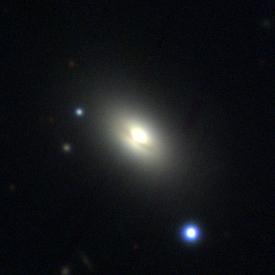NGC 703 facts for kids
NGC 703 is a special type of galaxy called a lenticular galaxy. It's located in the Andromeda constellation, which is a group of stars that form a pattern in the night sky. This galaxy is incredibly far from our own Milky Way galaxy – about 255 million light-years away!
Contents
What is a Lenticular Galaxy?
A lenticular galaxy is a bit like a mix between a spiral galaxy (like our Milky Way) and an elliptical galaxy. Imagine a lens or a Frisbee – that's kind of what a lenticular galaxy looks like!
How Lenticular Galaxies Form
Scientists believe that lenticular galaxies might form when two spiral galaxies crash into each other. This huge cosmic collision can cause the spiral arms to disappear, leaving behind a smooth, disk-like shape. They also don't have much gas and dust, which means they don't form many new stars. Most of their stars are old.
Key Features of Lenticular Galaxies
- No Spiral Arms: Unlike spiral galaxies, lenticular galaxies don't have those beautiful, swirling arms.
- Central Bulge: They usually have a bright, round bulge in the middle, similar to spiral galaxies.
- Flat Disk: Around the bulge, there's a flat, disk-shaped part, but it's much smoother than a spiral disk.
- Older Stars: Because they don't have much gas and dust, they mostly contain older stars and don't have many areas where new stars are being born.
Where is NGC 703 Located?
NGC 703 is found in the Andromeda constellation. This constellation is famous for being home to the Andromeda Galaxy, which is the closest large galaxy to our Milky Way.
The Andromeda Constellation
The Andromeda constellation is named after a princess from ancient Greek myths. It's one of the 88 modern constellations and can be seen in the Northern Hemisphere's night sky. It's best viewed in the autumn.
How Far is 255 Million Light-Years?
A light-year is the distance light travels in one year. Light travels incredibly fast – about 300,000 kilometers (186,000 miles) per second! So, 255 million light-years is an enormous distance. It means the light we see from NGC 703 today actually left that galaxy 255 million years ago. Imagine what was happening on Earth back then! Dinosaurs were just starting to roam the planet.
Discovery of NGC 703
NGC 703 was first discovered in 1786. Many astronomical objects were found around that time as telescopes became more powerful.
Who Discovered NGC 703?
The famous astronomer William Herschel discovered NGC 703. He was a German-born British astronomer who made many important discoveries, including the planet Uranus. His sister, Caroline Herschel, was also a very important astronomer.
Why Do We Study Galaxies Like NGC 703?
Studying galaxies like NGC 703 helps scientists understand how the universe works. By looking at different types of galaxies, we can learn about how they form, how they change over time, and how they interact with each other.
Learning About the Universe's Past
Because light takes so long to travel across space, when we look at distant galaxies like NGC 703, we are actually looking back in time. The light from NGC 703 shows us what the galaxy looked like 255 million years ago. This helps astronomers piece together the history of the universe.
Understanding Galaxy Evolution
Galaxies aren't static; they change and evolve over billions of years. By studying different galaxies at various distances (and thus different points in time), astronomers can create a timeline of galaxy evolution. This helps us understand how our own Milky Way galaxy might have formed and how it will change in the future.
See also

- In Spanish: NGC 703 para niños


